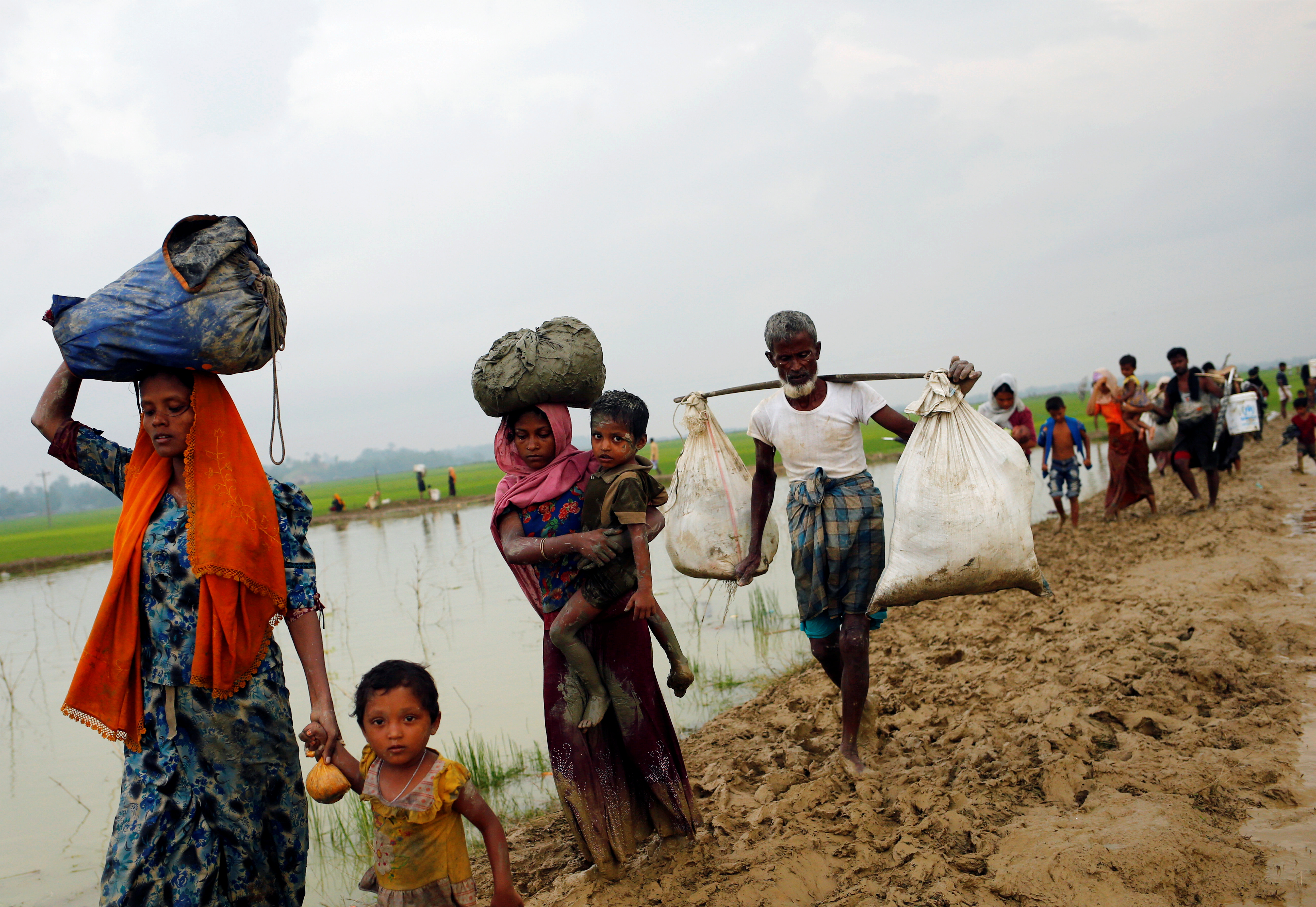
By Simon Lewis and Krishna N. Das
SHAMLAPUR, Bangladesh/DHAKA (Reuters) – Myanmar leader Aung San Suu Kyi came under more pressure on Tuesday from countries with Muslim populations to halt violence against Rohingya Muslims that has sent nearly 125,000 of them fleeing over the border to Bangladesh in just over 10 days.
Reuters reporters saw hundreds more exhausted Rohingya arriving on boats near the Bangladeshi border village of Shamlapur on Tuesday, suggesting the exodus was far from over.
Indonesian foreign minister Retno Marsudi, in Dhaka to discuss aid for the fleeing Rohingya, met her Bangladeshi counterpart, Abul Hassan Mahmood Ali, a day after urging Suu Kyi and Myanmar army chief Min Aung Hlaing to halt the bloodshed.
“The security authorities need to immediately stop all forms of violence there and provide humanitarian assistance and development aid for the short and long term,” Retno said after her meetings in the Myanmar capital.
The latest violence in Myanmar’s northwestern Rakhine state began on Aug. 25, when Rohingya insurgents attacked dozens of police posts and an army base. The ensuing clashes and a military counter-offensive have killed at least 400 people and triggered the exodus of villagers to Bangladesh.
The treatment of Buddhist-majority Myanmar’s roughly 1.1 million Muslim Rohingya is the biggest challenge facing Suu Kyi, who has been accused by Western critics of not speaking out for the minority that has long complained of persecution.
Myanmar says its security forces are fighting a legitimate campaign against “terrorists” responsible for a string of attacks on police posts and the army since last October.
Myanmar officials blamed Rohingya militants for the burning of homes and civilian deaths but rights monitors and Rohingya fleeing to neighboring Bangladesh say the Myanmar army is trying to force them out with a campaign of arson and killings.
“Indonesia is taking the lead, and ultimately there is a possibility of ASEAN countries joining in,” H.T. Imam, a political adviser to Bangladesh Prime Minister Sheikh Hasina, told Reuters.
He was referring to the 10-member Association of South East Asian Nations that includes both Myanmar and Indonesia.
“If we can keep the pressure on Myanmar from ASEAN, from India as well, that will be good … If the international conscience is awakened, that would put pressure on Myanmar.”
Malaysia, another ASEAN member, summoned Myanmar’s ambassador to express displeasure over the violence and scolded Myanmar for making “little, if any” progress on the problem.
“Malaysia believes that the matter of sustained violence and discrimination against the Rohingyas should be elevated to a higher international forum,” Malaysian Foreign Minister Anifah Aman said in a statement.
Turkey’s President Tayyip Erdogan, who has said the violence against Rohingya Muslims constituted genocide, told Suu Kyi the violence was of deep concern to the Muslim world, and he was sending his foreign minister to Bangladesh.
Indian Prime Minister Narendra Modi begins a visit to Myanmar on Tuesday, during which he will meet top officials, including Suu Kyi.
Pakistan, home to a large Rohingya community, has expressed “deep anguish”.
FULL CAMP
The latest estimate of the numbers who have crossed into Bangladesh since Aug. 25, based on calculations by U.N. workers, is 123,600.
That takes to about 210,000 the number of Rohingya who have sought refuge in Bangladesh since October, when Rohingya insurgents staged smaller attacks on security posts, triggering a major Myanmar army counteroffensive and sending about 87,000 people fleeing into Bangladesh.
Refugees arriving in Shamlapur, and residents of the village, said hundreds of boats had arrived on Monday and Tuesday with several thousand people.
Reuters reporters saw men, women, children and a few possessions, including chickens, disembark from one boat.
“The army set fire to houses,” said Salim Ullah, 28, a farmer from Myanmar’s village of Kyauk Pan Du, gripping a sack of belongings.
“We got on the boat at daybreak. I came with my mother, wife and two children. There were 40 people on the boat, including 25 women.”
The new arrivals – many sick or wounded – have strained the resources of aid agencies and communities already helping hundreds of thousands of refugees from previous spasms of violence in Myanmar.
Vivian Tan, a spokeswoman for the U.N. refugee agency, UNHCR, said one camp in Bangladesh, Kutupalong, had reached “full capacity” and resources at others were being stretched.
“We are doing what we can, but will need to seek more resources,” Tan said.
Bangladesh is concerned about Myanmar army activity on the border and would lodge a complaint if Bangladeshi territory was violated, an interior ministry official said.
A Bangladesh border guard officer said two blasts were heard on Tuesday on the Myanmar side, after two on Monday fueled speculation Myanmar forces had laid land mines.
One boy had his left leg blown off near a border crossing before being brought to Bangladesh for treatment, while another boy suffered minor injuries, the officer, Manzurul Hassan Khan, said, adding the blast could have been a mine explosion.
The Myanmar army has not commented on the blasts near the border but said in a statement on Tuesday Rohingya insurgents were planning bomb attacks in Myanmar cities including the capital, Naypyitaw, Yangon and Mandalay to “attract more attention from the world”.
(Reporting by Simon Lewis and Nurul Islam in COX’S BAZAR, Wa Lone and Shoon Naing; in YANGON and Ruma Paul in DHAKA; Writing by Antoni Slodkowski; Editing by Robert Birsel and Clarence Fernandez)












